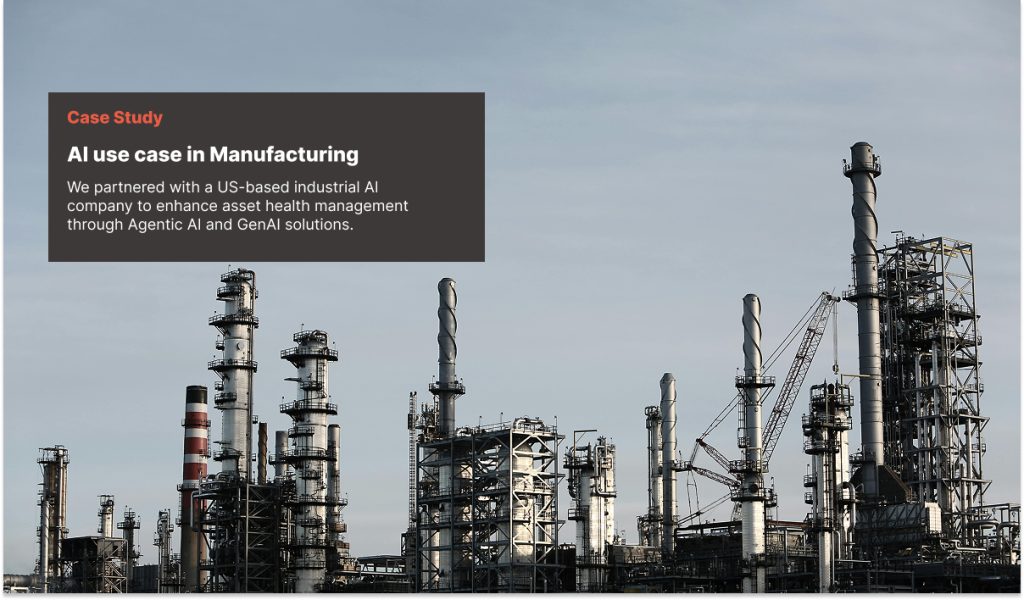The use of artificial intelligence in manufacturing is changing how plants monitor equipment health, reduce downtime, and optimize maintenance. In this case study, we explore how InteligenAI partnered with a U.S.-based industrial AI company to build a domain-specific, AI-powered asset health monitoring platform for manufacturing environments.
Executive summary
We built an industrial agentic platform for our client that delivers AI-powered anomaly detection, diagnostics, and maintenance insights to large-scale manufacturing plants. Its AI agents are trained on real-world equipment data and workflows built specifically for plant operators, not data scientists.
At its core, the platform offers a data-rich environment containing:
- Asset-level operational parameters: Each asset refers to a critical piece of plant equipment such as turbines, pumps, compressors, or generators tracked individually with real-time performance data.
- Maintenance history and scheduling: Records of past repairs, replacements, and service intervals to support predictive planning.
- Performance benchmarks: Tracking of plant-specific Key Performance Indicators (KPIs) such as equipment uptime, mean time between failures (MTBF), and energy efficiency metrics.
- FMEA timelines: Chronological mapping of failure modes and effects analysis (FMEA), which identifies potential failure points in equipment and their impact, used to prioritize reliability strategies.
Challenges faced by manufacturing companies
- Skill gap: Manufacturing plants struggle to find professionals who understand both complex machinery and digital/AI tools.
- Skill disconnect: Operators lack data science expertise. Data scientists lack domain knowledge in plant operations. This leads to inefficient diagnostics.
- High O&M costs: Without accurate early warnings, organizations either over-maintain or react too late, causing costly downtime and inefficiencies.
Our solution: Agentic AI for asset health management
InteligenAI designed and implemented an end-to-end AI solution for real-world plant conditions. This system brings together IoT data, ML models, conversational AI, and visual diagnostics into a unified platform.
Asset health management:
We built ML models that process IoT sensor data to deliver:
- Accurate anomaly detection with minimal false positives
- Root cause analysis using context from historical data
- Proactive maintenance suggestions based on patterns
Reliability engineer co-pilot:
An AI agent to support reliability engineers by providing:
- Interpretation of fault signatures
- Decision-making support using historical and real-time data
- Interpretation of the sensors’ performance at an instance in different working conditions, along with supporting and related sensors
- Fault mode analysis
Operator co-pilot:
We implemented a Conversational AI layer that empowers plant operators to:
- Get guided assistance through SOPs and troubleshooting
- Complete information about the architecture and functioning of the plant and equipment associated
- Receive just-in-time alerts and training cues
Vision AI integration:
We also contributed to backend integration for a visual diagnostics module that:
- Detects visual anomalies associated with different components in the equipment using image input
- Aids inspections by highlighting patterns and degradation
- Complements sensor-based diagnostics for better coverage
Key features delivered
| Feature | Description |
|---|---|
| NLP-based Chatbot | Conversational interface for equipment queries, SOPs, and troubleshooting |
| Anomaly Detection Engine | High-precision IoT data monitoring with minimal false positives |
| FMEA-Linked Diagnostics | Real-time diagnostics mapped to historical failure patterns |
| Vision AI Module | Image-based anomaly detection using AI-powered visual processing |
| Operator Interface | Simplified user interface for frontline plant personnel |
Results achieved
The platform is deployed across manufacturing facilities. These are the general results:
- Reduced unexpected downtime
- Lowered operations & maintenance (O&M) costs
- Improved collaboration between operations, reliability, and engineering teams
- Faster root cause identification and resolution
- Improved operator productivity and confidence
Why traditional predictive maintenance doesn’t scale
| Limitation | Industry Reality |
|---|---|
| Built for data scientists | 40% of plants lack dedicated reliability engineers, and even fewer employ data scientists |
| False positives from ML only systems | 70% of ML-only alerts are false, leading to wasted effort and higher maintenance costs |
| Unstructured & offline data | 70% of diagnostic data is unstructured or paper-based, making analysis time-consuming |
This platform overcomes these constraints by embedding agentic AI systems that can understand industrial data in all its forms, structured, semi-structured, or offline, and act contextually.
Conclusion
This project of AI in manufacturing demonstrates how agentic AI systems can bridge the gap between operators and data, empowering both frontline teams and reliability engineers with actionable intelligence. From anomaly detection to conversational diagnostics and visual inspection, these tools are becoming essential for manufacturers aiming to improve reliability, reduce costs, and scale efficiently.
Ready to transform your business with AI?
At InteligenAI, we specialize in building practical, scalable, and production-ready AI solutions across all industries for businesses of all scales. To explore custom AI solutions, contact us or book a free consultation with our founder and AI strategist.
